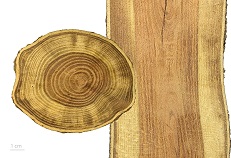Wooden windows? Wood, not for the frame but for the transparent part, instead of glass? Yes, modern research has shown that we can make transparent wood with a relatively benign chemical treatment. A new application for this biobased material! Windows made from transparent wood are good insulators – interesting because glass is not good at this job.
 Wooden windows could be very interesting
Wooden windows could be very interesting
Researchers from the University of Maryland published on this new opportunity last month in ScienceAdvances. We learned about their work through an article in The Conversation. Why would someone consider wood as a material for windows? Because wooden windows can be made thin, transparent and lightweight, and because the material is strong; moreover, because of its insulating properties, the material allows energy efficient constructions. Glass is very transparent, but it is a bad insulator. That’s why we need double glazing. Wood on the other hand is a good insulator but not transparent – until recently.
In recent years, researchers have succeeded in making wood transparent. That is interesting. For, as one article notes, wood is characterized by ‘its renewable and abundant origin, interesting optical properties, outstanding mechanical performance, low density, low thermal conductivity, and great potential for multifunctionalization.’ Wood has very good mechanical properties, even when it is thin. Wooden windows would make a sustainable solution. But until quite recently, methods for making transparent wood were quite energy intensive; and they used harmful chemicals. The article in ScienceAdvances now shows a more sustainable chemical method for making wooden windows.
 Non-transparent wood can be made transparent
Non-transparent wood can be made transparent
The main components of wood are cellulose and lignin. Lignin absorbs light mainly in its ‘chromophores’. These are chemical structures that absorb light (that’s why wood is non-transparent) and lend wood its brownish colour. Cellulose mainly consists of hollow tubes, that scatter light and add to the non-transparent properties of ordinary wood. In earlier work, researchers tried to remove the lignin completely, and replace this with some sort of resin. But lignin removal requires harmful chemicals and it weakens the material. The University of Maryland researchers have shown now that lignin removal isn’t necessary. Instead, they brush hydrogen peroxide (H2O2) on the wood, quite like when bleaching paper pulp. This substance penetrates into the wood and changes the structure of the chromophores, so they no longer absorb light. Then they expose the wood to UV light; this finishes the work of hydrogen peroxide, turning wood to become white. Finally, they infiltrate the wood with a special epoxy, that fills the cavities in the cellulose tubes. These now no longer scatter the light. This results in a transparent material that still has the original mechanical properties of wood.
Many opportunities
Once we accept that we can make transparent wooden windows, it is tempting to fantasize what else we can do with this technique. We could treat larger pieces of material for interesting construction effects. We could paint patterns in our wooden windows, for instance for indoor applications. This new technique could open up a whole new area of applications. Needless to say however, that we have only discussed research so far; industrial application may take some time to develop. As the author of the article in The Conversation notes: ‘Further work needs to be done to optimise the reaction with wood, and to incorporate it into an industrially automated process. But one day, in the future, you might be sitting in a home or working in a building with wooden windows.’
Interesting? Then also read:
Straw, an excellent construction material
Timber, the old and new construction material
Bamboo, a promising feedstock
